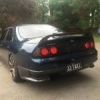Bleeding Brakes With Endless Amounts Of Air Bubbles :/ (r33 Gtst)
Announcements
-
Similar Content
-
Latest Posts
-
These things happen And I believe "we, the people, who modify stuff, and actually use it, cannot have nice things" It's just a shame that it happened so soon after paint I still win the award for quickly destroying newly painted panels I think, as my car came back from the paint shop all nice and shiny, until about 4 hours later when the boot was destroyed by a wayward locker that was blown around by the wind.... What doesn't kill you makes you stronger, and poorer.....dooh
-
This. And also, the rotor thickness is constrained by the calipers. Cannot be much thicker, if at all. Cannot be much thinner, if at all. New rotors are....fairly cheap. Turbo calipers can still be picked up for sensible money. Arguably, the best thing is to get R32 calipers and put them on mount spacers on 324mm discs. That's about the cheapest and easiest way to get quite large brakes that are essentially bolt on. And that's despite maintaining for years that the R32 calipers are not the best choice because they seem to be more flexy and creaky than the others. If you were prepared to put up with nasty little NA sliding calipers, these will still seem like Brembos by comparison.
-
Greg, you are the reason you cannot have nice things.
-





Recommended Posts
Create an account or sign in to comment
You need to be a member in order to leave a comment
Create an account
Sign up for a new account in our community. It's easy!
Register a new accountSign in
Already have an account? Sign in here.
Sign In Now